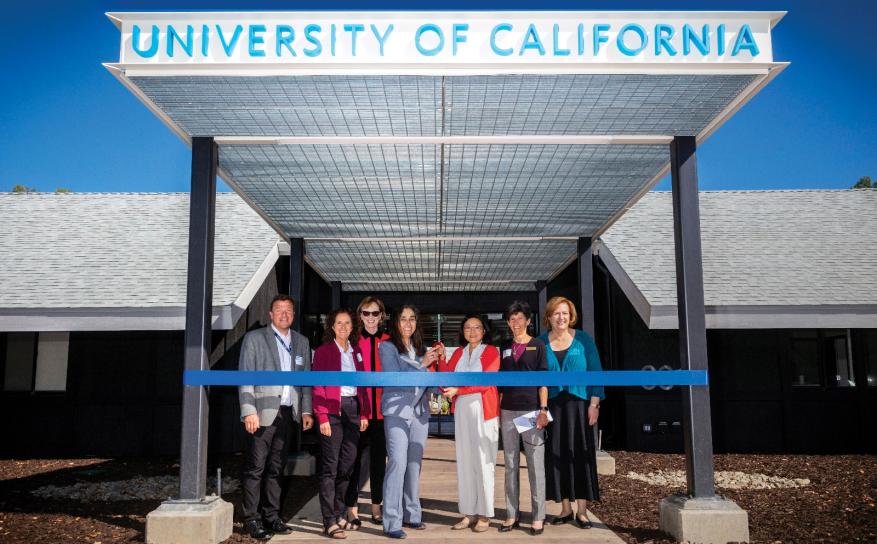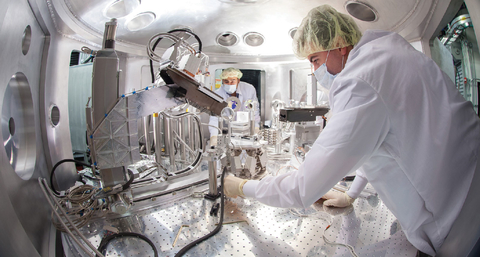Sharing S&T expertise and capabilities to meet our nation’s most important needs
LLNL engages in wide-ranging partnerships with sister laboratories and research institutions, academia, and industry. Many collaborations integrate disparate expertise and capabilities with focus on innovations to meet challenging mission objectives. Others serve to transition science and technology (S&T) breakthroughs into new applications and products.
Expanding University Partnerships
Academic collaborations began with the Laboratory’s founding as part of the University of California. Ties to the many UC campuses will be further strengthened with the formal opening in FY 2022 of the new University of California Livermore Collaboration Center (UCLCC). The center occupies the newly renovated Hertz Hall complex, which had been established as a branch of the UC Davis Department of Applied Science. UCLCC will serve as a UC multi-campus hub to expand collaborations and partnerships with the Lawrence Livermore, Lawrence Berkeley, and Los Alamos national laboratories. The three buildings in the UCLCC complex include eight general offices, a general lab, a small conference room, and a variety of classrooms that can easily be reconfigured for various uses.
These UC ties and other university collaborations play a vital role in keeping LLNL at the leading edge of innovation in support of its national security mission. The Laboratory’s Academic Engagement Office, formerly called University Relations, fosters collaborations and sustains long-term partnerships between LLNL researchers and the academic community, helping to ensure a pipeline of new ideas and people. For example, after three years of growing institution collaboration, the leaders of Case Western Reserve University and LLNL signed a memorandum of understanding in FY 2022 to accelerate their efforts in such areas as energy, materials science, and polymer processing.
The nEXO Experiment
LLNL leads for the DOE Office of Science the nEXO project to search for a rare type of nuclear decay called neutrinoless double beta decay (NDBD). It is a large collaborative effort, engaging approximately 200 scientists and technologists from 36 institutions and eight countries, including five DOE national laboratories and more than a dozen U.S. universities. NDBD has not yet been observed and cannot occur according to the known laws of physics because the decay process generates matter without creating antimatter. Detection would be a major discovery and provide key insight into the formation of the universe. nEXO will search for NDBD with a large detector isolated from cosmic rays by being built at a depth of two kilometers in SNOLAB, Canada’s deep underground research laboratory, located in a mine in Ontario, Canada. Late in 2022, DOE allocated to LLNL $2.35 million to support nEXO with funding from the Inflation Reduction Act, which aims in part to provide DOE national laboratories with resources to keep the U.S. at the forefront of scientific discovery. The funding will advance nEXO toward the formal definition phase of DOE project development (CD-1).
Expanding Partnerships in AI and Laser S&T
In December 2021, LLNL established an Artificial Intelligence Innovation Incubator (AI3) as a collaborative hub for uniting experts from the Laboratory, industry, and academia to advance AI and machine learning for large-scale scientific and commercial applications. The incubator provides a place where experts with diverse backgrounds and approaches can come together, nurture ideas, and grow projects that push the frontiers of what is possible. As highlighted throughout this Annual Report, AI is a “tool of the future” that is already providing breakthrough advances in many mission areas at the Laboratory.
LLNL will be designing and constructing one of the world’s most powerful petawatt (quadrillion-watt) lasers for installation of an upgrade to the Matter in Extreme Conditions experimental facility at SLAC National Accelerator Laboratory’s Linac Coherent Light Source. The new facility will provide unprecedented high-throughput capability for high-energy-density scientific discovery and national security research. The new laser will advance technologies present in the High-Repetition-Rate Advanced Petawatt Laser System (HAPLS) that Livermore developed for the European Union’s Extreme Light Infrastructure Beamlines facility. In FY 2022, agreement was reached for LLNL to upgrade L3-HAPLS performance from 0.5 petawatt peak power to 1 petawatt and triple the repetition rate to 10 Hertz.
Innovative Industrial Partnerships
LLNL is benefiting the U.S. economy with innovative technology and methods. In FY 2022, Livermore obtained 109 new patents, asserted 143 new copyrights, and executed 191 new licenses. Licensing income for the year totaled approximately $5.4 million. Among honors, LLNL earned three R&D 100 awards from R&D World Magazine. Laboratory laser researchers received an award for high-energy low-dispersion (HELD) diffractive gratings that facilitate future development of ultrahigh-power, ultrafast laser systems (see Science and Technology). Two R&D 100 awards pertain to advances in additive manufacturing: the first for “Tailored Glass Using Direct Ink Writing Technology” and the second for “Energy Inks” that not only enable 3D printing of battery and supercapacitor components but optimize their functional properties. In addition, LLNL and ArcelorMittal, a steel and mining company, received DOE High Performance Computing for Manufacturing program funding to apply to computer vision and machine learning to reduce defects and carbon emissions in steelmaking.
Center for Global Security Research Workshops
The Laboratory’s Center for Global Security Research (CGSR) partners with the community of national security experts to examine emerging national security challenges in the areas of deterrence, assurance, and strategic stability, as well as global challenges ranging from climate change to biosecurity. The center holds seminars with outside speakers, convenes timely workshops on key security issues, and shares study results through widely distributed publications. In FY 2022, CGSR held 10 workshops on topics ranging from the future of deterrence and multi-domain strategic stability to strategy and statecraft in cybersecurity.







